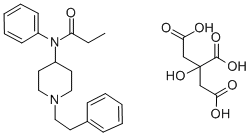Fentanyl citrate
- CAS No.
- 990-73-8
- Chemical Name:
- Fentanyl citrate
- Synonyms
- r5240;fentaz;FENTANES;sublimaze;mcn-jr4263;mcn-jr-4263-49;FENTANYL CITRATE;Leptanal citrate;phentanylcitrate;FENTANYLCITRATE,USP
- CBNumber:
- CB6172899
- Molecular Formula:
- C28H36N2O8
- Molecular Weight:
- 528.59
- MDL Number:
- MFCD00058359
- MOL File:
- 990-73-8.mol
| Melting point | 153-156°C |
|---|---|
| Flash point | 11 °C |
| storage temp. | 2-8°C |
| solubility | Soluble in water, freely soluble in methanol, sparingly soluble in ethanol (96 per cent). |
| form | Powder |
| color | Crystals |
| Water Solubility | Soluble to 40 mM in water |
| CAS DataBase Reference | 990-73-8(CAS DataBase Reference) |
| FDA UNII | MUN5LYG46H |
| NCI Dictionary of Cancer Terms | fentanyl citrate |
| NCI Drug Dictionary | fentanyl citrate |
SAFETY
Risk and Safety Statements
| Symbol(GHS) |   GHS08,GHS06 |
|||||||||
|---|---|---|---|---|---|---|---|---|---|---|
| Signal word | Danger | |||||||||
| Hazard statements | H334-H330-H317-H310-H300 | |||||||||
| Precautionary statements | P261-P285-P304+P341-P342+P311-P501-P262-P264-P270-P280-P302+P350-P310-P322-P361-P363-P405-P501-P261-P272-P280-P302+P352-P333+P313-P321-P363-P501-P264-P270-P301+P310-P321-P330-P405-P501-P260-P271-P284-P304+P340-P310-P320-P403+P233-P405-P501 | |||||||||
| Hazard Codes | T+,T,F | |||||||||
| Risk Statements | 26/27/28-42/43-39/23/24/25-23/24/25-11-36/37 | |||||||||
| Safety Statements | 7-16-36/37-45-36/37/39-26 | |||||||||
| RIDADR | UN 2811 6.1/PG 2 | |||||||||
| WGK Germany | 3 | |||||||||
| RTECS | UE5600000 | |||||||||
| HazardClass | 6.1(b) | |||||||||
| PackingGroup | III | |||||||||
| HS Code | 2933330000 | |||||||||
| Toxicity | LD50 in mice (mg/kg): 11.2 i.v.; 62 s.c. (Gardocki, Yelnosky) | |||||||||
| NFPA 704 |
|
Fentanyl citrate Chemical Properties,Uses,Production
Chemical Properties
White Powder
Uses
Fentanyl citrate can be used as an analgesic.
Definition
ChEBI: The citric acid salt of fentanyl, comprising equimolar amounts of citric acid and fentanyl. A mu-opioid receptor agonist, it is a potent opioid analgesic used in the management of labour pain, postoperative pain, and chronic intractable canc r pain. It is also widely used as the analgesic component of balanced anaesthesia.
brand name
Actiq (Cephalon); Sublimaze (Akorn).
Biological Activity
Potent and selective μ -opioid receptor agonist (K i values are 7.0, 151 and 470 nM for μ -, δ - and κ -opioid receptors respectively). Displays antinociceptive activity in vivo .
Clinical Use
A fentanyl patch is available for the treatment of severe chronic pain. This dosage form delivers
fentanyl transdermally and provides effective analgesia for periods of up to 72 hours. In 1999,
fentanyl also became available in a lollipop dose form for absorption from the oral cavity.
Fentanyl's short duration of action after parenteral dose is caused by redistribution rather than by
metabolism or excretion. Repeated doses of fentanyl can result in accumulation and toxicities.
Elderly patients usually are more sensitive to fentanyl and require lower doses.
Opioids have a wide spectrum of P-glycoprotein (P-gp) activity, acting as both substrates and
inhibitors, which might contribute to their varying CNS-related effects. Although fentanyl,
sufentanil, and alfentanil did not behave as P-gp substrates, they inhibited the in vitro
P-gp–mediated efflux of drugs known to be P-gp transported, such as digoxin, increasing their
blood levels and the potential for important drug interactions by inhibition of P-gp efflux
transporter.
Safety Profile
Poison by ingestion, subcutaneous, and intravenous routes. When heated to decomposition it emits toxic fumes of NOx. See also PHENTANYL.





